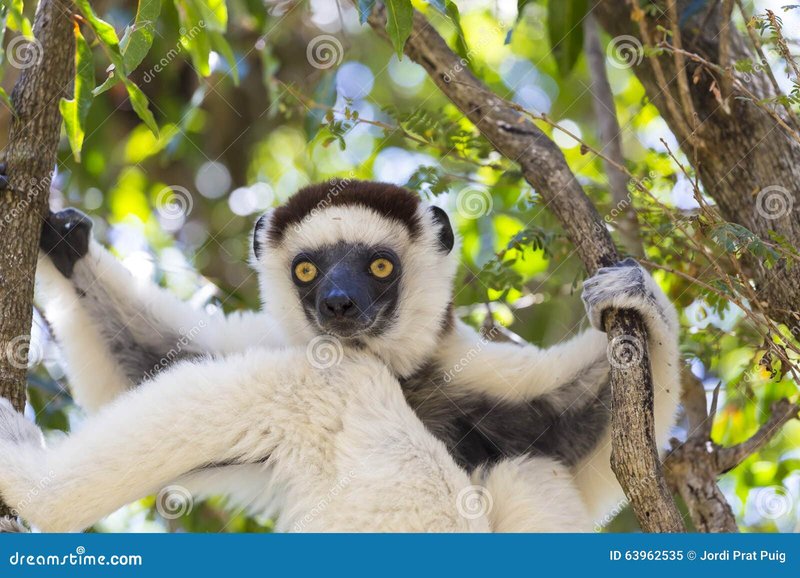
Imagine trying to find a meal while suspended high above the ground. It’s kind of like a high-stakes scavenger hunt, where the prize is lunch! The sifaka is an expert at this challenge, using its keen instincts and unique adaptations to thrive in its natural habitat. Let’s dive deeper into how these amazing animals hunt for their meals and what they eat to stay healthy.
What Do Sifakas Eat?
Sifakas are primarily herbivores, which means they mainly munch on plants. Their diet consists of a variety of leaves, fruits, flowers, and even bark. You might be wondering why they focus on such specific food sources. Well, lemurs like the sifaka have evolved to efficiently process the tough vegetation found in Madagascar’s forests.
One of their favorite snacks is the leaves of the cassava plant, which provide the necessary nutrients to fuel their active lives. They also enjoy fruit when it’s in season, adding a sweet touch to their otherwise leafy diet. Here’s a quick breakdown of what you might find on a sifaka’s menu:
- Leaves – The bulk of their diet.
- Fruits – A tasty treat during the right seasons.
- Flowers – A source of additional nutrients.
- Bark – When other options are scarce, they nibble on bark for survival.
This varied diet helps sifakas adapt to their surroundings and ensures they get a balanced mix of nutrients. It’s pretty fascinating how these animals can thrive on such a specific selection of foods!
How Do Sifakas Find Food?
For sifakas, hunting for food isn’t exactly a typical hunt. They don’t chase prey like some animals might. Instead, they rely on their keen sense of smell and vision to locate edible plants high up in the trees. They often travel in groups, called troops, which helps them spot food sources more easily.
Being social creatures also has its perks—when one sifaka finds a tasty leaf or fruit tree, the others are quick to join in the feast. This sharing behavior enhances their survival, as it ensures every member of the troop has access to food.
Moreover, sifakas are highly agile. They can leap between trees with impressive grace, covering distances of up to 30 feet in a single bound. This incredible leaping ability allows them to reach various food sources that may be out of reach for other animals.
Seasonal Variation in Sifaka Diets
Like many animals, the sifaka’s diet can change with the seasons. Madagascar experiences distinct wet and dry seasons, and these shifts can impact food availability. During the rainy season, when fruits are abundant, sifakas may indulge more in sweet treats. But once the dry season rolls around, they often revert to their staple diet of leaves and bark.
This adaptability is crucial for their survival. Sifakas have evolved to be able to extract nutrients from tougher plant materials when their favorite fruits are hard to come by. Here’s how the seasons can impact their eating habits:
- Wet Season – Higher fruit availability leads to more variety in their diet.
- Dry Season – They rely more on leaves and tough vegetation.
- Nutrient Recycling – The ability to switch diets helps them maintain health year-round.
Understanding these seasonal dietary changes reveals just how resilient sifakas are in adapting to their environment. It’s like having a backup plan—essential for thriving in unpredictable conditions!
The Sifaka’s Hunting Techniques
While hunting for food might not mean chasing after prey for the sifaka, they do exhibit certain strategies that reflect their foraging prowess. Sifakas are known for their keen observational skills when searching for food. They spend a good portion of their day scanning their surroundings to spot clusters of leaves or ripe fruits.
Another interesting aspect of their hunting technique is their use of calls. Sifakas have distinct vocalizations that can signal the presence of food to fellow troop members. You might think of it like sending out a friendly text to let your friends know where the pizza is! This social communication is key in helping the troop maximize their foraging efforts.
Additionally, these primates employ a strategy known as “leaping.” By jumping from branch to branch, they can quickly reach higher foliage where they often find the tastiest leaves. Their powerful legs and strong muscles allow them to navigate the treetops with ease and efficiency.
Predator Awareness While Foraging
While on the hunt for food, sifakas must constantly be on guard for predators. Madagascar is home to various threats, including birds of prey, reptiles, and even domestic animals. The sifaka’s high canopy lifestyle provides some safety, but they still need to stay alert.
To protect themselves while foraging, sifakas use their strong social bonds. Troops often take turns keeping watch while others eat, creating a communal sense of safety. If a predator is spotted, they’ll make quick, sharp calls to warn the others. This is where their teamwork shines—the sifakas quickly retreat to the safety of higher branches to avoid danger.
In this way, their foraging tactics are not just about finding food but also about ensuring the safety of the entire troop. It’s a balancing act of satisfying hunger while remaining aware of their surroundings.
The Role of Sifakas in Their Ecosystem
Beyond their own survival, sifakas play a crucial role in the health of their environment. As herbivores, they help control plant growth and seed dispersal. When they munch on leaves and fruits, they inadvertently help other plants thrive. Through their movement from tree to tree, they spread seeds across the forest, aiding in plant reproduction.
This process is essential for maintaining the biodiversity in their habitat. The more diverse plants there are, the more stable the ecosystem becomes. Sifakas are like little gardeners in the forest, helping to cultivate the very space they live in.
Additionally, their presence can indicate the health of the ecosystem. A thriving sifaka population often suggests a balanced environment rich in diverse plant life. This connection highlights the importance of conservation efforts focused on protecting these remarkable creatures and their ecosystems.
Conservation Challenges for Sifakas
Despite their resilience, sifakas face significant threats due to habitat loss and human activities. Deforestation, primarily for agriculture and logging, drastically reduces their natural home. As trees disappear, so does their food supply, which poses serious challenges for their survival.
Conservation programs are essential to combat these issues. Efforts include reforestation projects and creating protected areas where sifakas can thrive without the threat of habitat destruction. Local communities are often involved in these initiatives, understanding that a healthy ecosystem benefits everyone.
Also, educating the public about the importance of sifakas and their role in the ecosystem can foster increased support for conservation. By promoting awareness and understanding, we can help ensure that these fascinating creatures continue to thrive in Madagascar for generations to come.
In conclusion, the diet and hunting strategies of the sifaka are a remarkable testament to adaptation and resilience. From their herbivorous eating habits to their clever foraging techniques, these primates are not only fascinating but also vital to their ecosystem. As we learn more about them, we can better appreciate the complexities of life in Madagascar’s unique environment and the importance of preserving it. Let’s continue to support efforts that protect these extraordinary animals and their forest homes.

